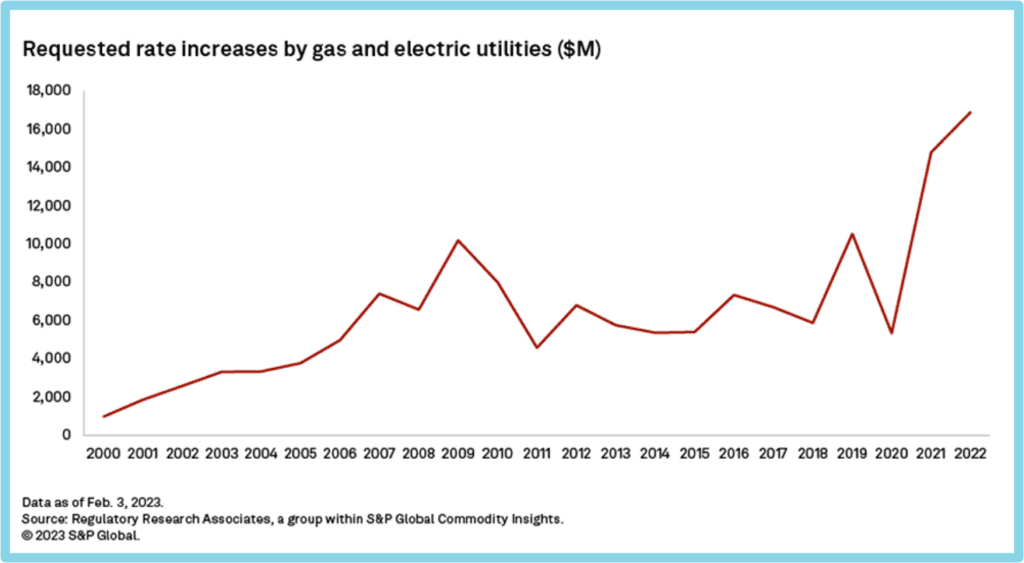- Business Transformation
- Sales & Revenue Optimization
- Finance & Operations
- Information Technology
- Private Equity
- Healthcare & Life Sciences
- High Tech
- Manufacturing
- Explore All Industries →
- Advisory + Diagnostics
- Change Management
- Implementation Services
- Cloud Application Managed Services
- Integrations
- Data Analytics
- Accelerators
- Cloud Applications
- Success Stories
- Insights + Events
- About Us
Rate Case Strategy Has Rarely Been More Complicated—or More Important
A changing business environment for the utility market means more variables to consider when preparing rate cases. New technologies like distributed energy resources (DERs), increased focus on adherence to safety regulations, grid modernization initiatives, and changing trends in consumption all affect your rate base. If you can plan effectively for these factors, you can set yourself up for negotiations with stakeholders and make smarter decisions about capital investments.
For many utilities, this means more strategic approaches to rate case planning and determining the appropriate rate base. Since 2020, requested rate increases have jumped sharply and stayed high. These numbers reflect the twin shocks of COVID-19 and the social urgency to adopt new technologies that consider environmental benefits, the latter of which will continue to impact utilities for the foreseeable future. As utility leaders strategize how to build rate cases that deliver the appropriate return, they’ll need quicker and smarter rate case planning processes to avoid being caught flat-footed.

Despite the importance of rate case strategy and the related corporate process, most utilities are using last-generation technologies and processes to generate insights on risks and opportunities. Cases are still planned for and developed using stand-alone spreadsheets and disparate systems, leading to manual process with difficult scenario analysis and reduced visibility. Being able to automate rate base planning and develop multiple scenario analyses is the next major step utilities need to take to determine effective negotiation strategies for rate setting.
Turn Analysts into Strategists
Without the right technology, many analysts spend their time managing data instead of analyzing it. Handled with disconnected systems, scenario analysis is typically a multi-day process where an executive asks for the outcomes of various scenarios based on static assumptions. “What would the impact on revenues be if we get this rate with our current trends for usage? How would a 5% cooler-than-usual summer affect revenue? What if the plant slated to go online next year is delayed 6 months?” Analysts work through these questions using static, offline models to answer the specific questions the executive asks. As a result, disconnected scenario analysis will give you the outcomes of a specific set of factors. As a result, the rate cases developed through this process are as reliable as the foresight of the executive asking questions—but no better than that. Given the shifts the energy landscape has undergone, your planning system needs to be more proactive than reactive.
Consider what this process might look like reversed. Begin by reviewing risks through connected planning models, develop your scenarios in response to what you find, and then provide this information to the executive team to make decisions. This gives you the opportunity to systematically evaluate risks from internal and external factors. Strategists can set and monitor thresholds for risk, allowing you to act earlier to mitigate the identified risk. Executives can be positioned to determine business paths out of a set of options that define the future as opposed to determining levers to pull and actions to take in one-off methods.
Your Rate Case Planning Systems Need Visibility
One of the trickiest challenges to address is visibility into the values used to develop rates. Not only does your rate case require data from across the company—the data you’re pulling often gets calculated based on a range of factors itself.
In an ideal state, the platforms used to facilitate your planning process should provide visibility into where numbers are derived from and how they are calculated to generate higher level outcomes. Ask yourself: How efficiently is your organization incorporating the general ledger and budget projections into capital plans and project execution? Can you forecast and plan at a rate category level? When developing your rate base, is it easy to see where adjustments to rates are required? How readily are your planning activities connected to see impact to balances you’re planning around (i.e., gross plant, depreciation, cost of removal, etc.)?
One way to handle this is to staff up, using teams of people to collect data and pass it between the relevant teams manually. But on top of the cost associated with this method, it also can cause as many complications as it solves, opening you up to manual errors and challenges with version control. Organizations benefit from smart connections between data sources, allowing users across the platform to see not just the values, but how they were generated. By allowing more fundamental insights into where the numbers are coming from, you can develop a trusted process.
Bottom Line: Connected Planning for Better Rate Cases
Technologies are available now to help organizations redeploy their workforce to more strategic work and gain deeper vision into strategic landscape. In our work with a wide range of utilities, we’ve deployed Anaplan, a highly customizable planning tool, to power connected planning processes like the one described above. As a result, utilities can more efficiently plan their rate cases and subsequently incorporate those cases back into the business plans. More strategic. More efficient. More informed.
Spaulding Ridge works with utilities to transform their process through data, delivering increased transparency and enhancing their strategic capabilities. If you’re interested in learning how your company could benefit from this work, I’d love to hear from you.







